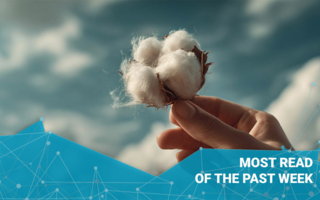11/11/2016 – Interview with José Sette — auf Deutsch lesen
How can cotton compete with Man-Made Fibers?
An interview with José Sette, Executive Director at International Cotton Advisory Committee (ICAC), Washington
Cotton is the world’s most widely used natural fiber, accounting for 27% of the global end-use consumption of fibers and 78% of all natural fibers produced in the world. However, since the middle of the 20th century,. The way how will be reacted to this threat determines the health of the world cotton sector in coming decades.
Mr. Sette, what are important factors still eroding the competitiveness of cotton?
José Sette: One of the most important factors eroding the competitiveness of cotton in the recent past has been the build-up in world inventories. Although the global stock-to-use ratio fell to 0.82 in 2015/16, world inventories remain at extremely high levels in historical terms.
Also the increasing difference between cotton and polyester prices has contributed to a reduction in competitiveness in the part of cotton and the decrease of its share in the global consumption of textile fibers. In recent months, a surge in cotton prices has further waekened the competitiveness of cotton in relation to other textile fibers.
Not only has the difference between cotton and polyester prices widened, but price volatility is once again rising. The extent of cotton price fluctuations and the gap between cotton and polyester prices have long-term adverse effects due to the uncertainty created throughout the cotton value chain. In addition, this situation encourages spinners to reduce the proportion of cotton in their blends in favor of polyester, which may result in a further drop in world cotton demand.
And what are the challenges faced by the world cotton sector?
José Sette: The world cotton sector races significant challenges to encourage growth in consumption. High cotton prices in 2010/11 brought about changes in the market for garments all over the world, as retailers realized that consumers were willing to purchase clothing with a high polyester content, so long as prices did not increase. The competition from man-made fibers is made even more formidable by some of the latest fashion trends. In recent years, the market share of man-made fibers has grown significantly as a result of the growing popularity of so-called “athleisure” products, which are designed for use while exercising and also for casual, everyday wear. This phenomenon is especially noticeable in women’s fashion, a category in which leggings and yoga pants, all of which tend to have a high polyester content, are increasingly worn in place of 100% denim (i.e. cotton) jeans. Furthermore, the application of new technologies to the manufacture of man-made fibers has resulted in more versatile and resistant materials, which combine cheap cost with a more natural appearance.
What would be useful measures for the cotton sector to counteract these adverse trends?
First, cotton prices must remain competitive. It may be difficult to match current low prices for polyester and any further decline in international cotton prices in relation to competing crops may generate a drop in cotton supply worldwide, since farmers would probably switch to other crops, such as corn, sorghum, soybeans, rice, wheat and sugarcane. Furthermore, any significant fall in cotton prices is likely to stimulate greater government intervention in support of local growers, which will temporarily prop up prices and delay adjustment to changing circumstances. Even so, the gap between the prices of the two products should not be allowed to widen even further. This means that cotton growers must continue to make every effort to lower their costs of production and increase productivity. Long-term investment in extension services and agronomic research is part of the solution. Yields in cotton production vary tremendously, and there is ample room for improvement in many cotton-producing countries, especially in Africa and Asia.
What about more investment in research ans development?
José Sette: Research must continue to be conducted into ways in which to improve the technical performance of cotton vis-à-vis competing fibers. Cotton has important natural qualities that are highly prized by consumers, but greater investment in research and development is required in order to improve its ease of use in industrial processes.
Is it not essential to enhance the image and reputation of cotton in the public perception?
José Sette: Cotton must do more to show its positive contributions to the world. Although often the target of unjust and misinformed attacks for its impact on the environment, cotton helps provide food security and income to hundreds of millions of people all over the world. We must all join together to educate the public regarding the benefits of this fiber.
What would be efficient instruments?
José Sette: Promotional campaigns can mold consumer preferences and help counteract the drop in consumption. The need to make consumers more aware of the advantages of cotton is particularly important in the emerging markets of Asia and Africa, where the bulk of population growth in coming decades will occur. Consumers in these markets often have little awareness of cotton and its benefits. Therefore, it is important to educate them so as to create loyal consumers in the future. Although the slow decline in its portion of world fiber consumption is likely to persist, the measures in my answers outlined above can help slow this decrease. Cotton can continue to play a leading role in world apparel and home furnishings, while raising the living standards of millions of needy people all over the world.
Mr. Sette, thank you very much for the interview
Source BREMEN COTTON REPORT NO. 43/44 – November 10, 2016
BREMEN COTTON REPORT is published by the Bremen Cotton Exchange. For more information about the history as well as todays aims and objectives of the Cotton Exchange visit: www.baumwollboerse.de




